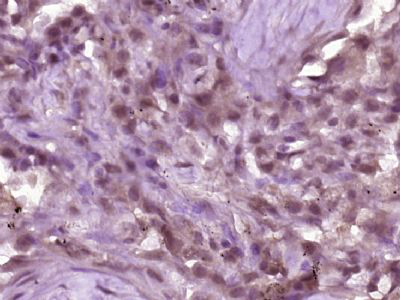产品货号 : mlR4286
英文名称 : VAV3
中文名称 : 鸟嘌呤核苷酸交换因子VAV3抗体
别 名 : Guanine nucleotide exchange factor VAV3; Protein vav 3; Protein vav3; VAV 3; Vav 3 guanine nucleotide exchange factor; VAV 3 oncogene; VAV 3 protein; VAV-3; Vav3; VAV3 oncogene; VAV3 protein; VAV3_HUMAN.
研究领域 : 肿瘤 免疫学 信号转导 转录调节因子 G蛋白偶联受体
抗体来源 : Rabbit
克隆类型 : Polyclonal
交叉反应 : Human, Mouse, Rat, Dog, Cow, Horse, Rabbit,
产品应用 : ELISA=1:500-1000 IHC-P=1:400-800 IHC-F=1:400-800 IF=1:100-500 (石蜡切片需做抗原修复)
not yet tested in other applications.
optimal dilutions/concentrations should be determined by the end user.
分 子 量 : 97kDa
细胞定位 : 细胞浆 细胞外基质
性 状 : Lyophilized or Liquid
浓 度 : 1mg/ml
免 疫 原 : KLH conjugated synthetic peptide derived from human VAV3:701-800/847
亚 型 : IgG
纯化方法 : affinity purified by Protein A
储 存 液 : 0.01M TBS(pH7.4) with 1% BSA, 0.03% Proclin300 and 50% Glycerol.
保存条件 : Store at -20 °C for one year. Avoid repeated freeze/thaw cycles. The lyophilized antibody is stable at room temperature for at least one month and for greater than a year when kept at -20°C. When reconstituted in sterile pH 7.4 0.01M PBS or diluent of antibody the antibody is stable for at least two weeks at 2-4 °C.
PubMed : PubMed
产品介绍 : The Vav family of Rho guanine nucleotide exchange factors (GEFs) orchestrate signaling events following lymphocyte antigen receptor activation. Vav3, like Vav (also known as Vav1 or p95Vav), undergoes tyrosine phosphorylation downstream of T cell receptor cross-linkage, and subsequently interacts with 2 adaptor molecules, SLP76 and 3BP2. Following these events, however, the paths of Vav and Vav3 diverge; Vav affects IL-2 promotor activity, while Vav3 impacts gene transcription linked to serum response element (SRE). Furthermore, Vav3 expression follows a cell cycle-dependent pattern, with transient upregulation occuring during mitosis. Encforced Vav3 expression leads to the appearance of multinucleate cells, implicating a role for Vav3 in the control of cytokinesis.
Function:
Exchange factor for GTP-binding proteins RhoA, RhoG and, to a lesser extent, Rac1. Binds physically to the nucleotide-free states of those GTPases. Plays an important role in angiogenesis. Its recruitement by phosphorylated EPHA2 is critical for EFNA1-induced RAC1 GTPase activation and vascular endothelial cell migration and assembly (By similarity). May be important for integrin-mediated signaling, at least in some cell types. In osteoclasts, along with SYK tyrosine kinase, required for signaling through integrin alpha-v/beta-1 (ITAGV-ITGB1), a crucial event for osteoclast proper cytoskeleton organization and function. This signaling pathway involves RAC1, but not RHO, activation. Necessary for proper wound healing. In the course of wound healing, required for the phagocytotic cup formation preceding macrophage phagocytosis of apoptotic neutrophils. Responsible for integrin beta-2 (ITGB2)-mediated macrophage adhesion and, to a lesser extent, contributes to beta-3 (ITGB3)-mediated adhesion. Does not affect integrin beta-1 (ITGB1)-mediated adhesion (By similarity).
Subunit:
Interacts with the PH domain of APS. Interacts (via SH2 domains) with the phosphorylated form of EPHA2. Interacts with ROS1; constitutive interaction that mediates VAV3 phosphorylation.
Tissue Specificity:
Isoform 1 and isoform 3 are widely expressed; both are expressed at very low levels in skeletal muscle. In keratinocytes, isoform 1 is less abundant than isoform 3. Isoform 3 is detected at very low levels, if any, in adrenal gland, bone marrow, spleen, fetal brain and spinal chord; in these tissues, isoform 1 is readily detectable.
Post-translational modifications:
Phosphorylated. Phosphorylation can be mediated by ROS1. In osteoclasts, undergoes tyrosine phosphorylation in response to CSF1 (By similarity).
Similarity:
Contains 1 CH (calponin-homology) domain.
Contains 1 DH (DBL-homology) domain.
Contains 1 PH domain.
Contains 1 phorbol-ester/DAG-type zinc finger.
Contains 1 SH2 domain.
Contains 2 SH3 domains.
SWISS:
Q9UKW4
Gene ID:
10451
Important Note:
This product as supplied is intended for research use only, not for use in human, therapeutic or diagnostic applications.
癌基因Vav3属于Vav家族癌基因蛋白类,它含有多个功能单位,主要通过信号传导,参与了肿瘤的发生发展过程,包括细胞骨架重组、钙离子内流、调控基因转录、对细胞可塑性和迁移的调节,对维持细胞形态,细胞的粘附,血管的生成,免疫细胞的调节,细胞的分化等发挥着作用。Vav3表达的失调与肿瘤的发生有一定的关联,并有着原癌基因的活性。
产品图片












